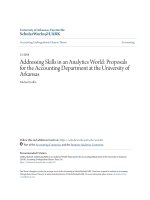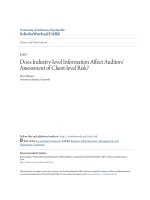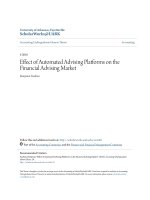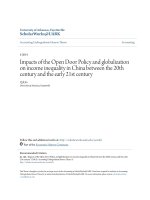Accounting undergraduate Honors theses: Potential consequences of U.S. securities and exchange commission’s replacement of the quarterly reporting requirement for semi annual reporting
Bạn đang xem bản rút gọn của tài liệu. Xem và tải ngay bản đầy đủ của tài liệu tại đây (257.26 KB, 13 trang )
University of Arkansas, Fayetteville
ScholarWorks@UARK
Accounting Undergraduate Honors Theses
Accounting
12-2018
Potential Consequences of U.S. Securities and
Exchange Commission’s Replacement of the
Quarterly Reporting Requirement for Semi-annual
Reporting
Mengchen Zhou
Follow this and additional works at: />Part of the Accounting Commons, and the Finance and Financial Management Commons
Recommended Citation
Zhou, Mengchen, "Potential Consequences of U.S. Securities and Exchange Commission’s Replacement of the Quarterly Reporting
Requirement for Semi-annual Reporting" (2018). Accounting Undergraduate Honors Theses. 37.
/>
This Thesis is brought to you for free and open access by the Accounting at ScholarWorks@UARK. It has been accepted for inclusion in Accounting
Undergraduate Honors Theses by an authorized administrator of ScholarWorks@UARK. For more information, please contact ,
Potential Consequences of U.S. Securities and Exchange Commission’s Replacement of the
Quarterly Reporting Requirement for Semi-annual Reporting
By
Mengchen Zhou
Advisor: Dr. Michael J. Crawley
An Honors Thesis in partial fulfillment of the requirements for the degree Bachelor of
Science in Business Administration in Finance and Accounting
Sam M. Walton College of Business
University of Arkansas
Fayetteville, Arkansas
December 14, 2018
Abstract
This study extends the discussion of potential consequences of U.S. Securities and
Exchange Commission’s replacement of the quarterly reporting requirement for semi-annual
reporting. This research summarizes the perspectives about quarterly and semi-annual reporting
from reporters, critics, business executives and academic researchers, analyzes the influential
parties from changing reporting regulation, and provides detailed explanation about potential
impacts. Five parties are related to the replacement of the quarterly reporting requirement,
including corporations, investors, analysts, auditors and Trump Administration. This research
concludes that the auditor will be the least influential party and corporations will be the most
impacted party.
Acknowledgements
I would first like to thank my thesis advisor, Dr. Michael J. Crawley from the Department
of Accounting, for his mentorship and guidance throughout this research. I would also like to
acknowledge Dr. Tim Riley from the Department of Finance as the second reader of this thesis,
and I am gratefully indebted to his valuable comments on this thesis.
Introduction
For decades, financial reporting has been the basis of U.S government security regulation.
Publicly-traded companies are required to file both annual reports and quarterly reports to disclose
financial information and business performance to the public and shareholders. Even though
quarterly reporting has been in effects for decades, U.S President Trump proposed a different
opinion to the current reporting regulation. On August 17, President Trump tweeted “In speaking
with some of the world’s top business leaders I asked what it is that would make business (job)
even better in the U.S. ‘Stop quarterly reporting & go to a six month system,’ said one. That would
allow greater flexibility & save money. I have asked SEC to study!” Trump also claimed he had
asked security regulators to consider replacing quarterly reporting requirements with semi-annual
filings. And his proposal was advocated by some business leaders including PepsiCo Chief
Executive, Indra Nooyi; Tesla Chief Executive, Elon Musk; and Parsley Energy Inc. Chief
Executive, Bryan Sheffield (“Trump backs CEOs,” 2018). Trump’s proposal also initiated a debate
about the advantages and disadvantages of stopping quarterly reporting.
The purpose of this paper is to expand the discussion about the consequences of stopping
quarterly reporting. The paper is divided into four separate sections: background information, a
literature review, analysis about influential parties, and conclusion. The background information
contains information related to the formulation and perfection of financial reporting, including the
creation of U.S Securities and Exchange Commission and the origin of financial reporting,
Sarbanes-Oxley Act, the development of financial reporting and current financial reporting filing.
The literature review includes an overview of the research conducted regarding quarterly reporting.
The analysis section presents opinions about involved parties and potential results of replacing
quarterly reporting for semi-annual reporting. The conclusion indicates a summary of research and
findings, with a feasible research method of improvement and future research opportunities.
Background Information
Financial Reporting Regulation:
1. The Creation of U.S Securities and Exchange Commission and the origin of financial
reporting.
There was no strong support for federal regulation of the stock market in 1920s. In October
1929, the security market experienced a massive crash, and one of reasons leaded to the crash was
that publicly-traded companies hid their financial information and business performance to
investors for accumulating capital. Later, the public confidence about the stock market shrunk, and
it expected the government to strengthen the supervision and regulation towards the stock market.
In order to reform the confidence of the public and to protect rights of investors, Congress passed
the Securities Act of 1933. This law, combined with the Securities Exchange Act of 1934, created
the U.S Securities and Exchange Commission (SEC). These two laws required publicly-traded
companies to tell the public about their business performance, the securities they sell, and the
potential risks of investment. And they also required that the people who trade securities (brokers,
dealers and, exchanges) must consider investor’s right as the first priority and treat investors fairly
and honestly (“The Laws That Govern the Securities Industry,” 2013). Securities Exchange Act of
1934 also regulated that the companies which have $10 million in total assets and are held by more
than 500 shareholders must fill annual and other periodic reports (“The Laws That Govern the
Securities Industry,” 2013). Overall, the SEC is a government agency whose objective is to
“protect investors, maintain fair, orderly, and efficient market, and facilitate capital formation”
(“What We Do,” 2013).
2. Turning point: Sarbanes-Oxley Act
After a series of accounting scandals involving Enron Corp and WorldCom, the reaction of
Congress was excellent and unexpected (Perino, 2002). It passed the “Sarbanes-Oxley Act of
2002” (SOX), a United States Federal Law that established new or expanded requirements for
boards of public-traded companies, management, and public accounting firms. Under the Section
302, SOX regulated the corporate responsibility for financial report: the signed officers must
review the report; the report should not contain any unreal statement of a material fact; the financial
information that is included in the report should “fairly present” the condition and operation of
companies; the signed officers are responsible for maintaining internal controls; they must
disclosure the ineffectiveness from internal controls and frauds that involve management or
employees who had roles in the internal controls; the report must contain information that whether
there were “significant changes” in internal control or some other factors effectively influence
internal controls (“PUBLIC LAW 107–204”,2002, p.33).
3. Financial Reporting: Development
As directed by Section 302 of the Sarbanes-Oxley Act of 2002, the SEC adapted the rules
to require that issuer’s financial officers and executives should verify the financial information
that is contained in the quarterly and annual reports. These officers are also responsible for
maintaining and evaluating internal controls, disclosing the consequences about internal controls
to auditors, and presenting the information on the reports about weather significant changes in
internal controls or other factors that affect the effectiveness of internal controls and evaluation.
In addition, issuers are also required to “maintain and regularly evaluate” the performance of the
disclosure controls and measurements that ensure that information presented on financial reports
filled under the Securities Exchange Act of 1934 is “recorded, processed, summarized, and
reported on a timely basis” (“Securities and Exchange Commission”, 2002).
4. Current Financial Reporting Filing
Under SEC regulation, most of U.S public companies are required to file “Annual Reports
on Form 10-K” which include corporations’ audited annual financial statements and summary of
the corporations’ business performance (“Public Companies,” n.d.). In addition to filling annual
reports, publicly reporting companies must submit “Quarterly Reports on Form 10-Q” which
included unaudited financial statements and business information for each of the first three quarters
in a year. Companies also fill “Current Report on Form 8-K” in order to notify investors about
companies’ major events such as changes in management or leaderships and earning release
(“Public Companies,” n.d.).
Literature review
U.S publicly-traded companies have been required to file quarterly reports since last
century, and this policy has never changed. The United Kingdom, however, stopped the mandatory
quarterly reporting in 2014. In “Consequences of Mandatory Quarterly Reporting: The U.K
Experience,” Nallareddy, Pozen, and Rajgopal (2017) presents and compares the results of
initiating mandatory quarterly reporting to that of terminating it. Initiating mandatory quarterly
reporting declines the number of firms that issued quantitative quarterly reports, but dramatically
increases the number of companies that release annual earning or sales guidance since companies
revised that guidance and consider it as a part of quarterly reports. Increased analysts’ coverage
and lower forecast error were also advantages of starting mandatory quarterly reporting
(Nallareddy, Pozen, Shivaram Rajgopal, 2017).
In addition, by utilizing different-in-different (D-i-D) analysis, Nallareddy, Pozen, and
Rajgopal (2017) find that stopping mandatory quarterly reporting is irrelevant to increased
companies’ capital from investors and changes in analysts’ forecast accuracy. Even though the
Financial Conduct Authority (FCA) terminated the mandatory quarterly reporting on Nov.7th 2014,
only 4 of 45 sample companies stopped quarterly reporting which indicated that most sample firm
voluntarily released their quarterly reports. In summary, the researchers conclude that extending
reporting term from three months to half a year “may not have significant effects on the time
horizons of U.S. company executives, absent other major changes such as those proposed by the
Kay Report” (Nallareddy, Pozen, Rajgopal, 2017).
Stopping quarterly reporting for semi-annual reporting becames a popular topic that led to
discussion. The positive influences from changing quarterly reporting to semi-annual reporting are
feasible. Matthew Abenante (2018) from Forbes Agency Council believes that stopping quarterly
reporting will reduce the costs of filling reports in terms of money and time (Abenante, 2018).
Cydney S. Posner (2018) from Cooley LLP also mentione that changing quarterly reporting to
semi-annual reporting would not only save corporations’ time and money, but also restrain “shorttermism” which companies only make efforts in attaining analysts’ quarterly expectation “at the
expense of long-term thinking.” (p.1). It also presentes that some groups believe the pressure of
quarterly reporting actually limited private companies to go public and public-traded companies
to maintain the status quo, so they agree with changing the periodic reporting system (Posner,
2018). Tensie Whelan, a professor from NYU’s Stern School of Business, elaborate that
concentrating on quarterly results has led to some negative effects: “ unprecedented share
buybacks, which artificially boost stock prices, non-strategic cost-cutting, less investment in
longer-term basic and applied research (versus product development), as well as an unhealthy
pressure on labor costs” (Whelan, 2018).
However, there are some proponents for quarterly reporting. Abenante also mention
companies which voluntarily filed quarterly reports would benefit from getting investors’ attention
if many companies shift to reporting semiannually. And quarterly conference calls also provide
investors a valuable opportunity to know companies’ insights about financial and business
performance (Abenante, 2018). Host Analytics’ CFO, Ian Charles (2018) underline the importance
of quarterly reports to investors and analysts. Quarterly earning reports are “the bread and butter
of information for shareholders and analysts” who are willing to receive up-to-date information,
and are considered as a method to “maintain transparency with companies they invest in.” (Charles,
2018, p.1). Ian Charles also cited the study of Kelley School of Business Research which indicate
that lacking information from semi-annual reports and transparency would cause investors to overreact to the news of target companies’ competitors and industry (Charles, 2018). Some experts at
Wharton and Georgetown University claim that switching to semi-annual reporting will have
tremendous disadvantages, including an incentive for the company to hide mistakes and an
increased possibility of inside trading. Wharton Professor David Zaring also believes quarterly
reporting is important to investors and built investors’ confidence because quarterly reports
provide more detailed information quickly, especially when companies change their business
strategies, release new products, and hire new executives (Business Radio, Podcast, 2018).
Jamie Dimon, chairman and CEO of JP Morgan Chase & Co, and Warrant Buffet, chairman
of Berkshire Hathaway Inc have different opinions compared to other researchers about quarterly
reporting. They advocated eliminating quarterly earnings-per-share guidance instead of quarterly
reporting. “In our experience, quarterly earnings guidance often leads to an unhealthy focus on
short-term profits at the expense of long-term strategy, growth and sustainability” (Rapoport,
2018).
Influential parties and potential consequences of replacing quarterly reporting for semiannual reporting
1. Corporations
The objectives of corporations are producing products or providing services to customers
that can develop business and generate profits. To managements of corporations, their basic
responsibilities are to maintain the daily operation and efficiently utilize the limited resources for
business process. Since publicly traded companies currently have to file quarterly reports,
switching to semi-annual reporting will make a huge impact on corporations.
Some corporations will keep filing quarterly reports even though the SEC requires less
frequent reporting. In the article “Consequences of Mandatory Quarterly Reporting: The U.K
Experience,” one phenomenon that researchers discovered was that only 9% of sample
companies (45 companies) stopped reporting quarterly when quarterly reporting was not
required, indicating that most sample companies would keep reporting their financials quarterly
(Nallareddy, Pozen, Rajgopal, 2017). These stoppers have two characteristics in common: they
were small companies by market capitalization, and they did not release managerial guidance
when they were required to file quarterly reports (Pozen, Nallareddy, Rajgpol, 2017). There a
few reasons that companies voluntarily still release their quarterly reports. First, since quarterly
reporting has been required so many years, preparing it becomes a “tradition” to corporations.
Second, if corporations on the expansion state that earned higher sales revenue and profits than
previous time periods, they would like to reveal their financials to the public for not only
showing their growth potentials but also strengthening their stockholders’ confidence.
Changing quarterly reporting to semi-annual reporting could benefit corporations if
companies want to hide their poor business performance. Investors are sensitive to information.
When companies disclose weak quarterly reports, investors may lose confidence about
companies and respond to the situation by selling their shares, making corporations’ stock prices
drop immediately. Therefore, corporations are able to mask their weak performance in specific
quarters when they are required to report semi-annually. However, if a corporation’s competitors
in the same industry continued to voluntarily report their quarterly earnings, the corporation
which does not release quarterly report would be suspected by investors for performing worse
than its competitors.
If corporations stopped disclosing quarterly reports, they may also miss chances to
accumulate more capital in the short-term when they beat earnings estimates. Analysts from
Wall Street estimate companies’ financial information such as earnings per share (EPS), revenue,
net income, earnings before income tax (EBIT), gross margin, as etc. In general, stock prices will
increase when a company beats the estimate and vice versa. The table below shows the earnings
history and price reaction of Apple Inc in last two years. The chart indicates that when Apple
reported earnings that beat estimates, its stock prices usually increase after earning release. On
average, in 2017 and 2018, Apple’s stock price will grow 3.65% and 5.1% respectively one week
and one month after the announcement of quarterly earnings reports. Filing and releasing strong
earnings reports will help corporations have higher liquidity, generate cash inflow from stock
trading, and increase market capital.
Announcement date
11/1/2018
7/31/2018
5/1/2018
2/1/2018
11/2/2017
8/1/2017
5/2/2017
1/3/2017
Fiscal period
Q4 18
Q3 18
Q2 18
Q1 18
Q4 17
Q3 17
Q2 17
Q1 17
Reported EPS
2.915
2.307
2.736
3.875
1.982
1.664
2.098
3.364
Estimated EPS
Surprise percentage
2.776
2.18
2.635
3.841
1.87
1.572
2.022
3.218
Change in price (one week after)
4.97%
5.52%
3.49%
1.28%
10.53%
5.96%
3.66%
4.35%
Average
-6.18%
8.84%
10.02%
-7.53%
4.62%
6.68%
4.39%
8.39%
3.65%
Change in price (one month after)
-19.64%
15.46%
10.88%
5.02%
1.75%
8.57%
3.56%
15.20%
5.10%
Table 1 Apple Inc Earning History & Price Reaction
Less frequent financial reporting will eliminate the stress, time and money of quarterly
reporting preparation. Bryan Sheffield, chief executive of Parsley Energy, believes removing
quarter reporting will help upper management: “We start preparing three weeks in advance every
quarter, essentially taking almost a third of executive’s time each quarter” (“Trump backs
CEOs,” 2018). Preparing a quarterly report requires a series of procedures and collaboration
between companies’ employees. For example, accountants spend time gathering data from
accounting journals to make quarterly reports; and top management ensure the establishment of
internal controls and review of financial statements. In addition, in the article “World semiannual
reporting really have a major effect on costs”, Cydney Posner (2018) mentions that review of
three quarterly reports occupies 15%-20% of overall costs (Posner, 2018) Therefore, if the SEC
does not require corporations to fill quarterly reports, the internal costs associated with quarterly
reporting will be reduced or eliminated. Moreover, Posner refers to the analysis from consulting
firm Audit Analytics, which indicates that large companies (accelerated and large accelerated
filers) paid audit fees of $541 per $1 million of revenue to their independent auditors, while
smaller companies paid $3,345 per $1 million in revenue (Posner, 2018). Although auditors do
not audit quarterly reports, the data reflects the phenomenon that small companies will benefit
more than large companies from reducing fixed costs.
2. Investors/shareholders
In the equity markets, when investors purchase stocks of a corporation, they become
shareholders of it. To investors, earing return on investment has always been regarded as the most
important as well as their ultimate objective. Investors usually utilize fundamental analysis and
technical analysis to evaluate a security. Technical analysis is a trading method that identifies
trading opportunities by analyzing statistical data and price trends of a security. In short, technical
analysis “tells” investors when they should buy a stock. However, ordinary investors usually use
fundamental analysis which is reviewing and analyzing objective companies’ financial statements
in order to reveal their business performance. The focus of fundamental analysis is on comparing
the current market price to the value suggested by the analysis, answering the question “What
stocks should investors buy?”. Since analyzing financial statements is a fundamental method for
investors to make investment decisions, changing reporting frequency will impact investors.
Less frequent financial reporting requirements for publicly-traded companies reduce the
availability of resources helping investors analyze target companies’ performance and make
investment decisions. Quarterly reports not only show the financial information about corporations
in specific periods, but also indicate the “growth” and “decline” of corporations. By comparing
the latest quarterly reports to previous ones, investors can clearly see whether their companies
expanded their business and made more profits or experienced a recession period with less revenue.
After analyzing quarter reports, investors are able to decide whether to buy or short the securities.
Under current reporting regulations, investors are able to see three 10-Q quarterly reports that
contain unaudited financial statements and operation information, and 10-K annual reports that
summarized the last three quarter reports and reports of the fourth quarter. After switching to semiannual reporting, investors can only view a semi-annual report and 10-K annual report. Therefore,
investors will review companies’ financial statements less frequently. In addition, a half-year
report does not contain data about each quarter so that investors are not able to realize the quarterly
business performance such as sales revenue and gross profits of target companies.
3. Analysts
The daily job of an analyst is to pick up coverage of a company, examine companies’
previous earning statements, and follow up the conference calls of top management of corporations.
If corporations are required to file semi-annual report of quarterly report, the work of
analysts will change dramatically. It will be difficult for analysts to gather quarterly data of
companies and they will estimate semi-annual financials instead of quarterly financials.
Analysts will also face the same problem with investors since they do not have abundant
information to evaluate companies. Not only do analysts estimate companies’ financial factors
such as EPS or net income, they also present opinions about the valuation and volatility of stock
so-called “analyst ratings”. In general, analysts evaluate whether the stock is a “buy,” “sell,” or
“hold”, presenting investment recommendation to investors. However, Jonathan Hwa (2013)
conducted a study about correctness of analyst ratings, showing that the rate of correctness for
analysts rating on the Dow 30 was only 51% (Huw, 2013). Consequently, if analysts do not have
enough information about companies’ financial and business performance, analysts rating will be
more inaccurate, potentially misleading investors’ investment decisions.
4. Auditors
The responsibility of an external auditor is to ensure financial statements do not contain
any material misstatement. By the end of companies’ fiscal year, auditors are able to review their
financial reports and give their opinion. Under SEC regulations, only corporations’ annual
financial statements must be audited by external auditors. Therefore, there is no significant
change in auditors’ work if SEC substitutes semi-annual reporting for quarterly reporting.
Auditors in the United States will not work more hours and extend the busy season unless semiannual reporting is required to be audited in the future.
5. Trump Administration
Naturally, Trump’s administration does not have strong connection with corporations’
reporting. However, since Trump proposes to change the quarterly reporting to semi-annual
reporting after meeting with business leaders, Trump will be influenced by his proposal. As an
initiator of a revolution, Trump will be likely to receive both criticism and compliments.
If Trump’s proposal of changing reporting requirements were approved and processed by
SEC, he would receive different treatment. On the one hand, Trump will be complimented and
supported by business leaders who intend to save money and time from abandoning quarter
reporting requirement. On the other hand, he will also be criticized by reporters, researchers and
some business executives who believe the advantages of utilizing quarterly reporting outweigh
that of using semi-annual reporting. In addition, if Trump’s proposal was accepted, that would
strengthen his leadership in the government administration, meanwhile that would also prove his
capability of managing the country and “making American great again” to the public, potentially
increasing his public approval rating.
Conclusion
In summary, five parties will be influenced if SEC replaced quarterly reporting requirement
for semi-annual reporting: corporations, investors, analysts, auditors and the Trump administration.
The auditor will be the least influential party since quarterly reports are not required to be audited,
and corporations will be the most impacted party.
Some corporations will voluntarily report quarterly. Corporations need time to get used to
filing semi-annual reports and also they would like to reveal their financials to show their growth
potential and strengthen the confidence of stockholders. Corporations are able to hide their
quarterly business performance and avoid negative effects when they experience recession if they
are required to file semi-annual reports rather than quarterly reports. However, investors may
figure out the real reason that a corporation refused to release quarterly reports if its competitors
in the industry release quarterly reports and show strong business performance. Companies may
also lose opportunities to generate more capital in short term. On the contrary, companies will no
longer worry about the cost of preparing quarterly reports. Especially, small companies will benefit
more than large companies from reducing fixed costs.
Analyzing financial statements and corporations’ reports is a basic method for investor to
evaluate companies’ business. If corporations report semi-annually, investors will have fewer open
resources to analyze companies’ performance, increasing the difficulty for them to make
investment decisions. Analysts can face the same problems that they do not have abundant
information to evaluate companies, leading to inaccurate estimate.
For the Trump Administration, Trump can get benefits such as potential supports from
business leaders, and reputation to the public; he can also be criticized by opponents of semiannual reporting. Even though Trump asked the SEC to study about switching to semi-annual
reporting, SEC chairman Jay Clayton said “I don’t think quarterly reporting is going to change for
our top names anytime soon.”
Reference
Trump backs CEOs, proposes easing corporate reporting rules. (2018, August 17).
Retrieved from />The Laws That Govern the Securities Industry. (2013, October 01). Retrieved from
/>What We Do. (2013, June 10). Retrieved from />Perino, M. A. (2002). Symposium enron and its aftermath: Enron's legislative aftermath: Some
reflections on the deterrence aspects of the sarbanes-oxley act of 2002. St.John's Law
Review, 76(4), 671-698. Retrieved from />PUBLIC LAW 107–204—JULY 30, 2002. (2012). Retrieved from
/>Securities and Exchange Commission 17 CFR PARTS 228, 229, 232, 240, 249, 270 and 274.
(2002, August 30). Retrieved from />Public Companies. (n.d.). Retrieved from />Nallareddy, S., Pozen, R., & Rajgopal, S. (2017, March 29). Consequences of Mandatory
Quarterly Reporting: The U.K. Experience. Retrieved from
/>Abenante, M. (2018, October 12). The Pros and Cons Of Switching from Quarterly To
Semiannual Reporting.
Retrieved from />Posner, C. S. (2018, August 17). Is semiannual reporting on the horizon? | Lexology.
Retrieved from />Whelan, T. (2018, August 23). Trump is right: Quarterly earnings reports should go. Retrieved
from />Charles, I. (2018, August 20). Why Semi-Annual Financial Reporting isn't Going to Work.
Retrieved from />Business Radio., Podcast. (2018). Should Companies Abandon Quarterly Earnings Reports?
Retrieved from />Rapoport, M. (2018, June 07). Buffett, Dimon Team Up to Curb 'Unhealthy Focus' on Quarterly
Earnings. Retrieved from />Pozen, R. C., Nallareddy, S., & Rajgopal, S. (2017, May 31). Impact of Reporting Frequency on
UK Public Companies. Retrieved from
/>Posner, C. (2018, September 07). Would semiannual reporting really have a major effect on
costs? Retrieved from />
Hwa, J. (2013, April 16). Study: 49% of Analyst Ratings on the Dow 30 Were Incorrect in 2012.
Retrieved from />









